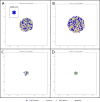This is a preprint.
Building multiscale models with PhysiBoSS, an agent-based modeling tool
- PMID: 38979487
- PMCID: PMC11230347
Building multiscale models with PhysiBoSS, an agent-based modeling tool
Update in
-
Building multiscale models with PhysiBoSS, an agent-based modeling tool.Brief Bioinform. 2024 Sep 23;25(6):bbae509. doi: 10.1093/bib/bbae509. Brief Bioinform. 2024. PMID: 39425527 Free PMC article.
Abstract
Multiscale models provide a unique tool for studying complex processes that study events occurring at different scales across space and time. In the context of biological systems, such models can simulate mechanisms happening at the intracellular level such as signaling, and at the extracellular level where cells communicate and coordinate with other cells. They aim to understand the impact of genetic or environmental deregulation observed in complex diseases, describe the interplay between a pathological tissue and the immune system, and suggest strategies to revert the diseased phenotypes. The construction of these multiscale models remains a very complex task, including the choice of the components to consider, the level of details of the processes to simulate, or the fitting of the parameters to the data. One additional difficulty is the expert knowledge needed to program these models in languages such as C++ or Python, which may discourage the participation of non-experts. Simplifying this process through structured description formalisms - coupled with a graphical interface - is crucial in making modeling more accessible to the broader scientific community, as well as streamlining the process for advanced users. This article introduces three examples of multiscale models which rely on the framework PhysiBoSS, an add-on of PhysiCell that includes intracellular descriptions as continuous time Boolean models to the agent-based approach. The article demonstrates how to easily construct such models, relying on PhysiCell Studio, the PhysiCell Graphical User Interface. A step-by-step tutorial is provided as a Supplementary Material and all models are provided at: https://physiboss.github.io/tutorial/.
Keywords: Agent-based modeling; Boolean modeling; Multiscale modeling.
Conflict of interest statement
Competing interests No competing interest is declared.
Figures



References
-
- Letort Gaelle, Montagud Arnau, Stoll Gautier, Heiland Randy, Barillot Emmanuel, Macklin Paul, Zinovyev Andrei, and Calzone Laurence. PhysiBoSS: a multi-scale agent-based modelling framework integrating physical dimension and cell signalling. Bioinformatics, 35(7):1188–1196, April 2019. ISSN 1367–4803. doi: 10.1093/bioinformatics/bty766. - DOI - PMC - PubMed
-
- Miguel Ponce-de Leon Arnau Montagud, Vincent Noël Gerard Pradas, Meert Annika, Barillot Emmanuel, Calzone Laurence, and Valencia Alfonso. PhysiBoSS 2.0: a sustainable integration of stochastic Boolean and agent-based modelling frameworks, April 2022. Pages: 2022.01.06.468363 Section: New Results. - PMC - PubMed
-
- Ghaffarizadeh Ahmadreza, Heiland Randy, Friedman Samuel H., Mumenthaler Shannon M., and Macklin Paul. PhysiCell: An open source physics-based cell simulator for 3-D multicellular systems. PLOS Computational Biology, 14(2):e1005991, February 2018. ISSN 1553–7358. doi: 10.1371/journal.pcbi.1005991. Publisher: Public Library of Science. - PMC - PubMed
Publication types
Grants and funding
LinkOut - more resources
Full Text Sources
